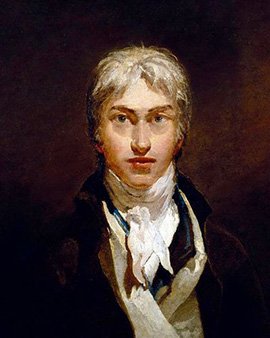William Turner - also known as the "painter of light" - is probably one of the most popular painters of the English Romantic period. His special interest in colors is one of the characteristics that distinguish especially his landscape and sea motifs.
For the son of a Devon-born wig and hat maker and a mother from an old family of wealthy butchers and shopkeepers, his entry into the art world was not entirely free of obstacles. But the London-born Turner quickly found his own way.
After early signs of mental confusion in his mother and her subsequent treatment at Bethlem Hospital, young Turner was sent to live with relatives in Brentford, Sunningwell, and eventually Margate. Upon his return to London, Turner's father quickly recognized his son's artistic talent and offered to display some of his works in the store window. In 1789, he was finally admitted to the Royal Academy Schools, where he met Thomas Malton, whom he later described as "his true master." He first began making stage sets - a task that suited his love of opera and music. Turner's varied occupations speak both to his wide-ranging interests and to the need to finance his existence at the Royal Academy, which exhibited his watercolors from 1790 and his oil paintings from 1796. There he made acquaintance with the painter and art historian John Ruskin, a member of the socially critical Arts and Crafts Movement, which he, together with William Morris, had a decisive influence on. Ruskin emerged as one of Turner's greatest supporters.
In 1802, Turner was officially elevated to "Academician" by the Royal Academy and recognized as a child prodigy - he was considered one of the most outstanding artists of his generation. Nevertheless, he initially encountered a number of critics there and often rubbed people the wrong way because of his self-confident manner. Moments that put him in his place as an artist. An episode in 1811, when the Prince Regent praised but did not buy one of Turner's paintings, quickly brought the young artist down to earth but his enthusiasm did not wane. Despite headwinds, Turner even managed to pay homage to critics and he always remained loyal to the Royal Academy.
Turner was primarily interested in the latest techniques and quickly began to question working methods of the old masters and go his own way. This was to eventually influence painters of the Romantic period. His preference for seascapes and later history paintings, show his urge to be more than a landscape painter. Not uncommon for Romantics, myths, history, and literature were to remain steadily important inspirations for the artist. Turner's flair for vivid color combinations give his works a special signature.
At the time, Turner's expressive treatment of rather conservative themes was met with criticism, but today is appreciated all the more by connoisseurs. He bequeathed a large part of his works to the English nation.
×





.jpg)
.jpg)
.jpg)
.jpg)
.jpg)
.jpg)
.jpg)
.jpg)
.jpg)
.jpg)
.jpg)
.jpg)
.jpg)
.jpg)
.jpg)
.jpg)
.jpg)
.jpg)
.jpg)
.jpg)
.jpg)
.jpg)
.jpg)
.jpg)
.jpg)
.jpg)
.jpg)
.jpg)
.jpg)
.jpg)
.jpg)
.jpg)
 The Morning after the Del - (MeisterDrucke-651625).jpg)
 The Morning after the Del - (MeisterDrucke-651625).jpg)
.jpg)
.jpg)
.jpg)
.jpg)
.jpg)
.jpg)
.jpg)
.jpg)
.jpg)
.jpg)
.jpg)
.jpg)
.jpg)
.jpg)
.jpg)
.jpg)
.jpg)
.jpg)
.jpg)
.jpg)
.jpg)
.jpg)
.jpg)
.jpg)
.jpg)
.jpg)
.jpg)
.jpg)
.jpg)
.jpg)
.jpg)
.jpg)
.jpg)
.jpg)
.jpg)
.jpg)
.jpg)
.jpg)
.jpg)
.jpg)
.jpg)
.jpg)
.jpg)
.jpg)
.jpg)
.jpg)
_-_(MeisterDrucke-690592).jpg)
_-_(MeisterDrucke-690592).jpg)
.jpg)
.jpg)
.jpg)
.jpg)
.jpg)
.jpg)
.jpg)
.jpg)
.jpg)
.jpg)
.jpg)
.jpg)
.jpg)
.jpg)
.jpg)
.jpg)
.jpg)
.jpg)
.jpg)
.jpg)
.jpg)
.jpg)
.jpg)
.jpg)
.jpg)
.jpg)
.jpg)
.jpg)
_-_(MeisterDrucke-309954).jpg)
_-_(MeisterDrucke-309954).jpg)
.jpg)
.jpg)
.jpg)
.jpg)
.jpg)
.jpg)
.jpg)
.jpg)
.jpg)
.jpg)
.jpg)
.jpg)
.jpg)
.jpg)
.jpg)
.jpg)
.jpg)
.jpg)
_-_(MeisterDrucke-685316).jpg)
_-_(MeisterDrucke-685316).jpg)
.jpg)
.jpg)
.jpg)
.jpg)
.jpg)
.jpg)
 - (MeisterDrucke-78193).jpg)
 - (MeisterDrucke-78193).jpg)
_-_(MeisterDrucke-686297).jpg)
_-_(MeisterDrucke-686297).jpg)
.jpg)
.jpg)
.jpg)
.jpg)
.jpg)
.jpg)
.jpg)
.jpg)
_-_(MeisterDrucke-1431211).jpg)
_-_(MeisterDrucke-1431211).jpg)
.jpg)
.jpg)
.jpg)
.jpg)
.jpg)
.jpg)
.jpg)
.jpg)
.jpg)
.jpg)
.jpg)
.jpg)
.jpg)
.jpg)
.jpg)
.jpg)
.jpg)
.jpg)
.jpg)
.jpg)
.jpg)
.jpg)
.jpg)
.jpg)
_-_(MeisterDrucke-317486).jpg)
_-_(MeisterDrucke-317486).jpg)
_-_(MeisterDrucke-382070).jpg)
_-_(MeisterDrucke-382070).jpg)
.jpg)
.jpg)
 - (MeisterDrucke-252336).jpg)
 - (MeisterDrucke-252336).jpg)
.jpg)
.jpg)
 1802 - (MeisterDrucke-66704).jpg)
 1802 - (MeisterDrucke-66704).jpg)
 - (MeisterDrucke-83729).jpg)
 - (MeisterDrucke-83729).jpg)
.jpg)
.jpg)
.jpg)
.jpg)
 - (MeisterDrucke-105784).jpg)
 - (MeisterDrucke-105784).jpg)
.jpg)
.jpg)






